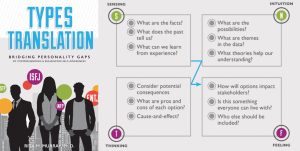Aspire to be Brainier?
Rita M. Murray, PhD
Think of recent times you have been discouraged or frustrated during a meeting. You wanted to dig deeper into the facts and history of an incident and your colleague leaped to a series of possible scenarios that, “explained everything.” Or, you chastised yourself because you voiced your objective opinion with clarity but failed to consider the feelings and values of others. Later, you found yourself saying, “What was I thinking?”
The answer? Too often in our meetings our thinking goes on “auto-pilot” and we fail to use the range of cognitive and/or mental functions available in our brain.
Collaborating with Myers-Briggs® type-aware teams, results in great success from working with a useful mental model. Initially developed by Isabel Myers, this practical model promotes a technique for the sequential use of all your cognitive functions to help you identify your own preferences, blind spot(s) or biases and deliberately use more of your brain power, i.e., be brainier; maybe even a brainiac.
The model purports that as you follow the zig-zag pattern of cognitive functions (forming a “Z” as shown in the graphic), you (and team members) work through data integration (Sensing), visionary themes and connections (iNtuition), critical inquiry (Thinking), and the impact on people (Feeling), to reach a comprehensive conclusion and an ultimate “brain workout.”
I included this model and its applications in the workbook, “Types Translation.”
What about you? Even if you are not psychological type aware, try this: when faced with a problem or decision, consider carefully the mental function(s) you trust most and typically access first. Click To TweetNotice how much time you tend to spend and how frequently you return there. Using the model, here’s a guide to those functions and preferences:
- Sensing (S). If you tend to trust and favor your “gift” of focusing on the details and facts, you attend to the “what is” of the problem and stay in the present (which is where your senses are) or you may address the “what was” and offer data from the past – after all, that is practical.
- Intuition (N). If you tend to immediately leap to ideas, “thinking outside the box,” big picture thinking – a “what could be” mindset – you trust/seek patterns and themes, first and naturally. After all, your imagination is rich with possibilities.
- Thinking (T). If you tend to approach problems rationally and objectively using “cause and affect logic,” your aim is to objectify elements seeking clarity and you easily distance yourself from others as you decide and get to the bottom line. After all, it is not personal.
- Feeling (F). If you tend to filter the impact of the decision or problem through your values and make decisions that are in harmony with your values first, and also through the impact it may have on others. After all, harmony creates human connection.
Applying this mental zig-zag pattern of S-N-T-F, in that order, allows you to fully leverage your own preference(s), stretch to develop your other mental preferences, and adapt to and take advantage of the preferences of those around you to improve performance and results.
So next time you find yourself getting exasperated in a meeting, choose to “be brainier,” using this model. You will learn other people’s “auto pilot” mental modes are not simply to be tolerated, but to be truly appreciated. That is your brain turned on to “win-win.”
Myers-Briggs Type Indicator, Myers-Briggs, and MBTI are trademarks or registered trademarks of the MBTI® Trust, Inc., in the United States and other countries.



Comments are closed.